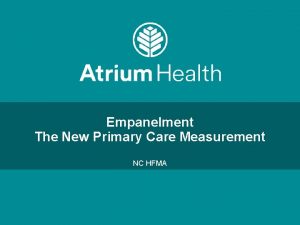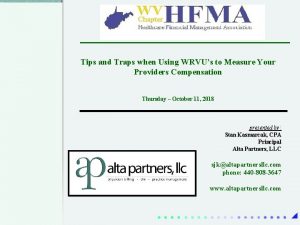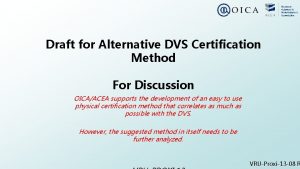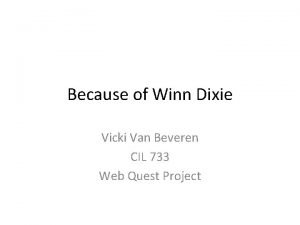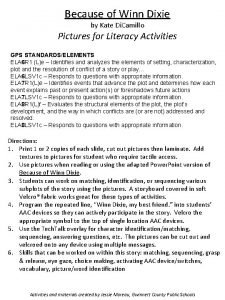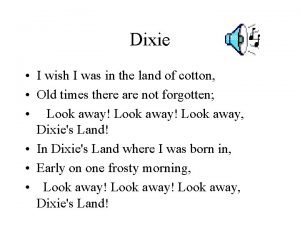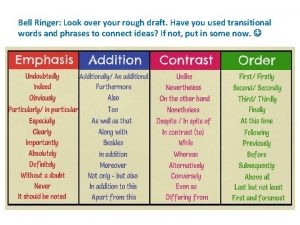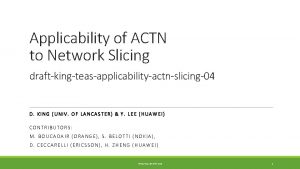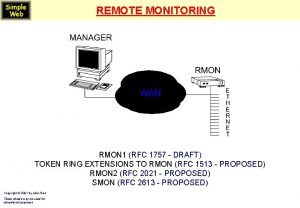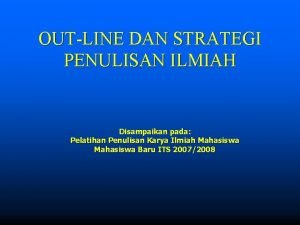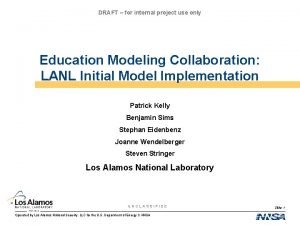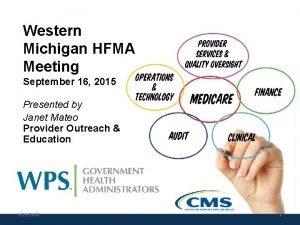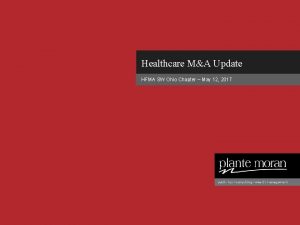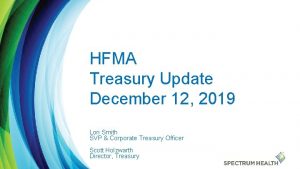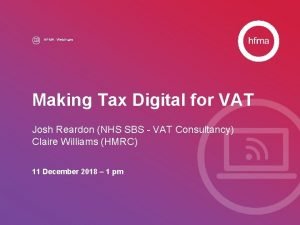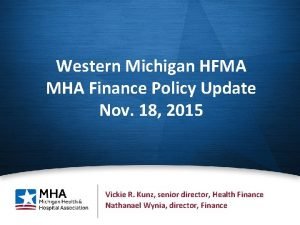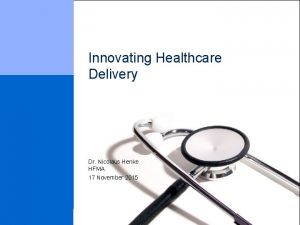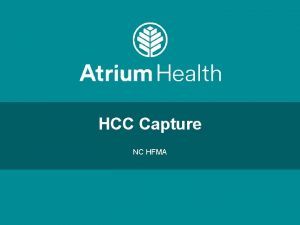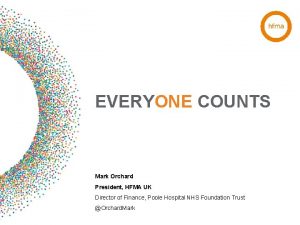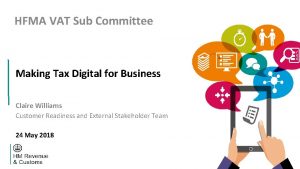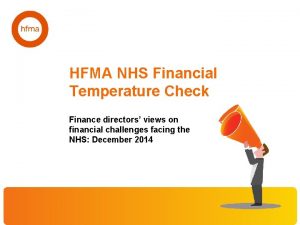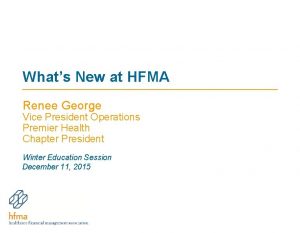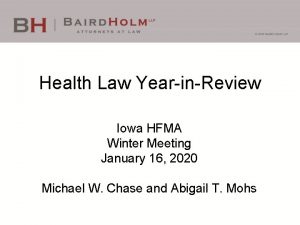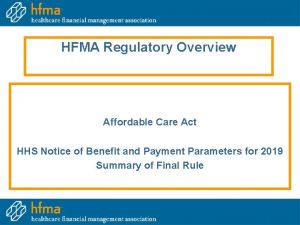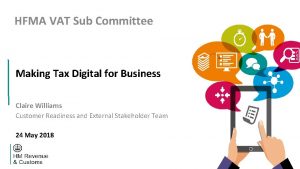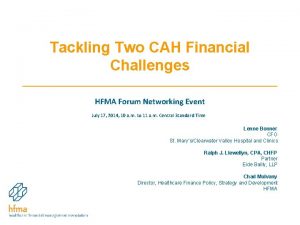DISCUSSION DRAFT 2 24 14 HFMA Dixie Institute

















































- Slides: 49

DISCUSSION DRAFT 2 -24 -14 HFMA Dixie Institute 2014 Be the Fortune Hunter in Your Revenue Cycle Process: Applying Lean Processes to the Physician Revenue Cycle to Improve Cash Flow and Decrease Staffing Costs February 24, 2014

DISCUSSION DRAFT 2 -24 -14 Agenda I. Introduction II. Overview III. Maximizing Revenue Cycle Performance IV. Patient Collections V. Key Metrics and Dashboards VI. Denial Tracking 0100. 015301107(pptx)-E 2 1

DISCUSSION DRAFT 2 -24 -14 I. Introduction 0100. 015301107(pptx)-E 2 2

I. Introduction ECG Management Consultants, Inc. DISCUSSION DRAFT 2 -24 -14 For 40 years, our mission has been to provide exceptional management consulting services to healthcare clients. • ECG is a national consulting firm focused on offering strategic, management, and financial advice to healthcare providers. • We are particularly known for our expertise in physician/hospital relationships, practice management (PM) process improvement, managed care contracting and strategy, strategic and business planning, and programmatic development. • Our over 130 consultants operate out of offices in Boston, Dallas, San Diego, San Francisco, Seattle, St. Louis, and Washington, D. C. • Since 1973, have completed thousands of major consulting engagements. – – More than 500 hospitals/health systems. 100 -plus medical groups 200 faculty practice plans. Over 100 of the nation’s medical schools and more than 250 teaching hospitals. We serve as trusted advisers to the nation’s leading healthcare providers. 0100. 015301107(pptx)-E 2 3

DISCUSSION DRAFT 2 -24 -14 II. Overview 0100. 015301107(pptx)-E 2 4

DISCUSSION DRAFT 2 -24 -14 II. Overview Session Objective The objective of this session is to understand the implications of improved practices for the revenue cycle. Specifically, by the end of this discussion, everyone should be able to: • Review critical revenue cycle functions and their impact on ultimate cash collections. • Understand the essential metrics to track and trend properly. • Understand the impact organizationally and culturally by implementing new processes. 0100. 015301107(pptx)-E 2 5

DISCUSSION DRAFT 2 -24 -14 II. Overview Healthcare Trends The word cloud below highlights the trends that are in focus as the new year approaches. NOTE: Size of word reflects degree of interest in trend. 0100. 015301107(pptx)-E 2 6

II. Overview Patient and Provider Technology DISCUSSION DRAFT 2 -24 -14 Forecasts indicate that by 2014, overall Internet consumption on mobile devices will exceed that of traditional computers. 1 Patient Consumerism Provider Consumerism • 4. 8 billion people own a • Sites where physicians can message each other, mobile phone and 4. 2 billion people own a toothbrush. 1 have private discussions, comment on presentations by peers, and hold virtual consultations, such as Quantia. MD, are thriving. • 48% of 18– 34 year-olds check Facebook before getting out of bed. 1 • Providers are also looking to expand services through virtual visits to reduce the inefficiencies of in-office visits, where the average clinical visit is 7 minutes with a 60 -minute wait. • The “consumerism” of healthcare is showing that patients are slowly becoming “customers” and will have more information and choices, which will enable self-directed care. • Price transparency and patient choice may drive providers to engage in “bidding wars” on sites such as Medi. Bid for select services. • Technologies being implemented now include patient portals, expanded telemedicine services, mobile apps for ER wait times, retail health centers, etc. 1 Geonetric, October 2013 Analysis Report and IHT 2 Infographic. It is important to separate the bleeding edge from the cutting edge, when providers are entertaining some of the IT options to foster consumerism. 0100. 015301107(pptx)-E 2 7

II. Overview Price Transparency – Notable Publications/Events DISCUSSION DRAFT 2 -24 -14 Healthcare price transparency is becoming an increasingly prominent topic. “The $2. 7 Trillion Medical Bill: Colonoscopies Explain Why U. S. Leads the World in Health Expenditures” – June 1, 2013 The article discusses the wide range of costs in the U. S. for a colonoscopy. One example compared the costs in New York City, about $8, 600, to Baltimore, $1, 600. “One hospital charges $8, 000 – another, $38, 000. ” – May 8, 2013 The story by Steven Brill, J. D. , discusses his findings after spending 7 months analyzing hundreds of bills from hospitals, doctors, drug companies, and medical equipment manufacturers. 0100. 015301107(pptx)-E 2 The article highlights the variance of three complex procedures between two hospitals within ¼ mile of each other in Miami, Florida. Cosponsors included Academy Health, Network for Regional Healthcare Improvement (NRHI), HFMA, and NCQA. 8

II. Overview Price Transparency – Increasing Pressure DISCUSSION DRAFT 2 -24 -14 The demand for organizations to be more transparent with their pricing will continue due to pressure from both patients and the government. Pressure from patients, who are increasingly carrying a greater burden of the costs. Pressure from CMS and state governments forcing organizations to be more transparent. Growth of HSA – Qualified High-Deductible Health Plan Enrollment, Covered Lives (Millions) 1 January 2013 2. 0 2. 6 January 2012 2. 5 3. 0 January 2011 2. 4 2. 8 January 2010 2. 1 3. 0 - 1 9. 6 7. 9 May 2013 – New information available to public … Data is being released that shows significant variation across the country and within communities in what providers charge for common services. This data includes information comparing the charges for the 100 most common inpatient services and 30 common outpatient services. 1. 2 0. 1 6. 3 5. 0 10. 0 Individual Small Group Other Group Uncategorized 15. 0 State of Arizona 20. 0 June 2013 – Law mandates that providers make available upon request or post online the “direct pay price” of their most commonly performed procedures. Hospitals will have to disclose the prices of their 50 most common services and physician practices their 25 most common services. Large Group Source: AHIP Center for Policy and Research, 2005– 2013 HAS/HDHP Census Reports. 0100. 015301107(pptx)-E 2 9

DISCUSSION DRAFT 2 -24 -14 III. Maximizing Revenue Cycle Performance 0100. 015301107(pptx)-E 2 10

DISCUSSION DRAFT 2 -24 -14 III. Maximizing Revenue Cycle Performance Functional Areas To improve cash collections, it is paramount to understand the eight functional areas in both the front end (clinics) and back end (business office). Revenue Cycle Functional Areas Front-End Functions Appointment Scheduling • Schedule appointments. • Make reminder telephone calls. Patient Registration • Gather demographic information. • Obtain insurance information. Time-of. Service (TOS) Collections • Collect copays. • Collect selfpay payments. • Arrange Back-End Functions Coding/ Charge Capture Charge Entry • Apply CPT Edit Resolution/ Claims Submission Payment Posting Account Follow-Up • Enter charges. • Submit primary • Post all • claims. payments and • Adjust adjustments. capitated • Submit • charges. secondary • Deposit money and ICD-9 codes to each encounter. claims. in the bank. Answer patient inquiries. Perform denials followup. • Resubmit financial agreements. claims. • Issue refunds. 0100. 015301107(pptx)-E 2 11

III. Maximizing Revenue Cycle Performance Revenue Cycle Process – Hospital Revenue Cycle 0100. 015301107(pptx)-E 2 12 DISCUSSION DRAFT 2 -24 -14

DISCUSSION DRAFT 2 -24 -14 III. Maximizing Revenue Cycle Performance Revenue Cycle Process – Physician Practice The flow chart below provides a high-level summary of the revenue cycle process. Charge Capture/Claims Submission Claim Adjudicate d? Chart in EMR Coder Require d? Generate A/R File No Create Pivot Table and Prioritize Work Yes Abstract Record Submit Remittance Review/Work Accounts No No Post Remittance Select Codes in EMR Yes Payabl e? No Develop and Submit Adjustment Packet Review Adjustment Packet Paid Accurately ? Scrub Edits in PM Generate Claim Form Resubmit Claim EDI Edits ? Resolve Edit (by responsible party) Yes End Yes No Research and Correct Claim No Approved ? Yes Post Adjustment Submit Claim Form to Payor 0100. 015301107(pptx)-E 2 Follow-Up/Resolution 13 Significant Resources Patient Care Event Claims Adjudication Payor

III. Maximizing Revenue Cycle Performance Current Billing Flow Diagram – Sample Practice Verify Patient Insurance Eligibility and Benefits Collect Co-Pay and File Claim to Insurance or Medicare Within 24 to 48 Hours of Visit Claim Denied and Discussed With Provider No Insurance Coverage/ Benefits Determined Patient Properly Registered at Front Desk Resulting Patient Balance: Two Statements Sent One Letter and Two Calls From Provider Office Claim Paid Correctly and Electronically Patient Balance Remaining Process Is Acceptable Practice Determination Adjust/Write Off Balance Patient Sent to Collections Balance <$50 Hardship Process Is Moderately in Place Process Needs Improvement 0100. 015301107(pptx)-E 2 Self-Pay Patient: Collect Partial or Entire Amount at Visit Previous Balance Collected File Claim Daily Electronically DISCUSSION DRAFT 2 -24 -14 14 Patient Discharged From Practice Financial Hardship: No Charge Make Payments or Pay Balance

III. Maximizing Revenue Cycle Performance Improvement Opportunities Abound DISCUSSION DRAFT 2 -24 -14 The revenue cycle process varies significantly across organizations, but the primary building blocks and associated challenges, especially those resulting from the Affordable Care Act (ACA), are comparable. A number of new technologies are available on the market to increase efficiency. 0100. 015301107(pptx)-E 2 15

DISCUSSION DRAFT 2 -24 -14 III. Maximizing Revenue Cycle Performance Front End Patient Chart Access Scheduling • Scanning vs. manual Scheduling updating of information (e. g. , insurance cards). • Access to other scheduling. • Lack of monitoring of no- • Reliability of servers. shows and cancellations. Patient Chart Access Front-End Operations Co-Pay Collection • Consistency of check-in use of “cash drawer” function. 0100. 015301107(pptx)-E 2 Arriving Patients • Tracking of payments/ consolidation of batching process. desk, which interrupts other front desk tasks. • No true open-access databases and unscanned paper charts. • Standardization and • Telephone triage at front process at each practice. Co-Pay Collection • Reliance on paper processes. • Training sites for new staff at busiest practices. 16

III. Maximizing Revenue Cycle Performance Back End and Billing DISCUSSION DRAFT 2 -24 -14 When considering physician billing, members of leadership must identify the degree to which they want to “manage” professional revenue cycle operations. Degree of Administrative Involvement Billing Model Description Advantages Disadvantages The majority of billing functions are completed in a central business office (CBO). • • Economies of scale. Consistency. Dedicated expertise. Standardized reporting and monitoring. • Opportunities for enhanced IT systems/resources. • Increased physician billing and Hybrid Some functions (e. g. , coding, charge capture/entry, co-pay posting) are completed at the site of service, while remaining functions are completed at the CBO. Best of both worlds. Requirement of additional training and reporting/control tools. Decentralized The majority of billing functions are completed/managed at the site of service (i. e. , each practice maintains a small business office). • Site-level control. • Close relationship with patients • Disparate standards and Functional areas (typically backend functions) are managed by a third party. This model enables the organization to focus on core competencies (e. g. , patient service). Centralized Outsourced 0100. 015301107(pptx)-E 2 and physicians, creating “ownership. ” • Prompt resolution of physiciandriven errors. 17 response lag. • Potential for “not my job” mind-set from front-end staff. processes. • Staffing inefficiencies. • Third parties are not likely to “care” as much for your patients. • There is a premium on billing services.

III. Maximizing Revenue Cycle Performance Ideal Model DISCUSSION DRAFT 2 -24 -14 Our experience has been that most organizations with a moderate-sized physician group find success deploying a hybrid strategy, which leverages economies of scale while also locating functional responsibilities where it can be serviced most efficiently. Centralized Decentralized 0100. 015301107(pptx)-E 2 18

DISCUSSION DRAFT 2 -24 -14 IV. Patient Collections 0100. 015301107(pptx)-E 2 19

DISCUSSION DRAFT 2 -24 -14 IV. Patient Collections Current Patient Statement Process – SAMPLE The figure below represents the current patient collection process once a patient is deemed to be self-pay or it is determined that a balance is the responsibility of the patient. Days 15 95% Statement 1 45 75% 75 45% Initial Nonpayment Letter Statement 2 135+ 105 25% <20% Final Letter The current process takes too long to identify a patient amount due and needs to be expedited. But along with implementing a patient financial policy, the organization needs to consider the possibility of discharging a patient from the practice for continued nonpayment. 0100. 015301107(pptx)-E 2 20 Approved Accounts Sent to Collections

DISCUSSION DRAFT 2 -24 -14 IV. Patient Collections Best Practices • • • Understand the profile of the patient. Appropriately work with consumer-directed healthcare. Set clear expectations. Ask for the money. Improve your statement process/patient portal. Go to the next level. 0100. 015301107(pptx)-E 2 21

DISCUSSION DRAFT 2 -24 -14 IV. Patient Collections Understand the Profile of the Patient Content Encourage “Bless Their Heart” TOS Collections (With the Medicaid/Charity Proper Encouragement) Call to Verify Bill Payment Plans Unlikely to Pay One Statement Collection Notice Bad Debt Candidate Patient Accounts Receivable Content Bless Their Heart Encourage 0100. 015301107(pptx)-E 2 22

DISCUSSION DRAFT 2 -24 -14 IV. Patient Collections Consumer-Directed Healthcare – High Deductible Plans • Patients’ failure to realize the type and deductible amounts. • Barriers to knowledge of plan type or amounts by provider. • Discomfort asking for full amount due. • Caught between not asking for enough from the patient and potentially having a significant increase in refund checks. 0100. 015301107(pptx)-E 2 23

DISCUSSION DRAFT 2 -24 -14 IV. Patient Collections Set Clear Expectations • • • Provision of financial policy – on Web site, in writing, etc. Initial scheduling of visit, procedure, or surgery. Collect an amount due toward the service provided. Insurance verification and then following through. Connecting the dots – Ability to know “all of the amounts due” by a patient. 0100. 015301107(pptx)-E 2 24

DISCUSSION DRAFT 2 -24 -14 IV. Patient Collections Ask for the Money • Ask “How would you like to pay? ” • Provide multiple payment options – cash, check, credit application. • Establish a minimum deposit. • Stop talking (and providing options to not pay). • Ask at each patient interaction necessary. • Then a miracle occurs… 0100. 015301107(pptx)-E 2 25

IV. Patient Collections Improve the Statement Process/Patient Portal DISCUSSION DRAFT 2 -24 -14 • Send daily statements. • Tighten the cycle process – two statements and one letter. • Accept credit cards on statements and through the billing office. • Consider extra charges, such as interest on the third correspondence. • Evaluate all options for bad debt recovery – internal and external. 0100. 015301107(pptx)-E 2 26

DISCUSSION DRAFT 2 -24 -14 IV. Patient Collections Go to the Next Level • • • Partner with an agency for early out. Utilize Web tools. Offer negotiated rates when the AR starts get stale. Review bad addresses to track patients. Be creative when contacting patients – “You have a message from your physician. ” • Be a financial advocate for the patient’s benefit. 0100. 015301107(pptx)-E 2 27

DISCUSSION DRAFT 2 -24 -14 V. Key Metrics and Dashboards 0100. 015301107(pptx)-E 2 28

“What Gets Measured, Gets Managed” – Jack Welch 0100. 015301107(pptx)-E 2 29 DISCUSSION DRAFT 2 -24 -14

V. Key Metrics and Dashboards Management’s Role – Dashboard DISCUSSION DRAFT 2 -24 -14 A dashboard is an excellent way to follow key performance indicators and important financial benchmarks within your practice. • This will allow you to seamlessly track financial information, practice quality measures, visit information, and patient satisfaction results. • A dashboard is designed to track important profitability metrics like patient arrivals, canceled appointments, cancellation reasons, no-show appointments, rescheduling/retention rate, and resource utilization. • It also shows relevant financial data, including gross charges, payments, contractual adjustments, days in accounts receivable (A/R), collections rate, and missing charges. • Patient satisfaction data can also be incorporated into a dashboard to allow analysis against financial, appointment, referral, and demographic practice results. 0100. 015301107(pptx)-E 2 30

V. Key Metrics and Dashboards Monitoring Performance – Example DISCUSSION DRAFT 2 -24 -14 Develop a dashboard so you can monitor the effectiveness of your billing operations, reduce controllable denials, and identify additional areas of opportunity. 0100. 015301107(pptx)-E 2 31

DISCUSSION DRAFT 2 -24 -14 V. Key Metrics and Dashboards Part 1 Metric Purpose Value Calculation Days in A/R Trending indicator of overall A/R performance. A/R Over 90 Days Trending indicator of Indicates revenue receivable collectability. cycle’s ability to liquidate A/R over 90 days divided by total A/R. Net Collection Percentage/Bad Debt Percentage Demonstrates Indicates collectible collectability of possible portion and bad debt. collections. Net collections divided by adjusted charges. Cash Collections Trending indicator of converting charges to cash. Pays the bills. Total payments (all sources). Demonstrates self-pay portion of total A/R. Self-pay A/R divided by total A/R. Self-Pay/Patient. Trending indicator of Responsible Portion A/R portion, which is of A/R self-pay versus insurance. Indicates revenue cycle A/R divided by average efficiency. charges (gross or net). The handouts provide a review of the metrics, purpose, value, and calculation for both the hospital and physician revenue cycle processes. 0100. 015301107(pptx)-E 2 32

DISCUSSION DRAFT 2 -24 -14 V. Key Metrics and Dashboards Part 2 Metric Purpose Value Calculation Payor Mix Charges by payor mix. POS Collections Trending indicator of POS Accelerates cash collection efforts. collections and reduces collection costs. POS payments divided by total payments. Clean Claims Rate Trending indicator of claims data. Indicates quality of data collected and reported. Number of claims that pass edits divided by total claims submitted. Credit Balance Percentage Tracking of credit balances for compliance and patient refunds. Indicates total credit balances. Total credit balances divided by total A/R. Days in Total Discharged Not Final Billed (DNFB) Trending indicator of Indicates revenue cycle claims generation process. performance and can identify performance issues impacting cash flow. Not final billed divided by average daily charges. Customer Service Calls Tracking calls from patients. Calls taken divided by calls presented (opposite of abandonment rate). 0100. 015301107(pptx)-E 2 Indicates portion by payor. Each payor’s charges divided by total charges. Indicates number of calls and relation to number of patient statements generated. 33

DISCUSSION DRAFT 2 -24 -14 VI. Denial Tracking 0100. 015301107(pptx)-E 2 34

DISCUSSION DRAFT 2 -24 -14 Is Doing Nothing an Option? Does this remind you of anyone? 0100. 015301107(pptx)-E 2 35

DISCUSSION DRAFT 2 -24 -14 VI. Denial Tracking Why We Track Denials In reviewing a practice’s EOBs, there always denials for patient eligibility, medical necessity, diagnosis coding, etc. • Tracking denials helps identify trends within the practice. – Find system issues that need to be resolved. – Identify concerns regarding payors trends and reimbursement. – Provide educational opportunities for both providers and staff. • Tracking denials from various sources will offer different representations regarding the claims. – EDI (system scrubber, clearinghouse, and payor) denials. – Payment posting. – Insurance specialists (follow-up). • It is important to provide feedback to staff and providers with education regarding denials. Improving the clean claim percentage can save significant time in the revenue cycle process. 0100. 015301107(pptx)-E 2 36

DISCUSSION DRAFT 2 -24 -14 VI. Denial Tracking Sample of Revenue Cycle Process The flow chart below provides a high-level summary of the revenue cycle process. Charge Capture/Claims Submission Claim Adjudicate d? Chart in EMR Coder Require d? Generate A/R File No Create Pivot Table and Prioritize Work Yes Abstract Record Submit Remittance Review/Work Accounts No No Post Remittance Select Codes in EMR Yes Payabl e? No Develop and Submit Adjustment Packet Review Adjustment Packet Paid Accurately ? Scrubber Edits in PM Generate Claim Form Resubmit Claim EDI Edits ? Resolve Edit (by responsible party) Yes End Yes No Research and Correct Claim No Approved ? Yes Post Adjustment Submit Claim Form to Payor 0100. 015301107(pptx)-E 2 Follow-Up/Resolution 37 Significant Resources Patient Care Event Claims Adjudication Payor

DISCUSSION DRAFT 2 -24 -14 VI. Denial Tracking Adjustments/Write-Offs To effectively establish denial reporting, proper adjustment codes need to be utilized. • Review adjustment codes – determine which should be utilized and create/add these codes to the adjustment policy to ensure proper use. • Use well-delineated adjustment codes. – Hardship. – Bad debt. – No referral/authorization. – Timely filing. – Not medically necessary. – No waiver signed. – Bankruptcy. – Timely review. – Provider not credentialed. • This helps to determine areas for improvement. Once these codes are in place, then payment posters can adhere to them while posting payments and working denied claims. 0100. 015301107(pptx)-E 2 38

DISCUSSION DRAFT 2 -24 -14 VI. Denial Tracking Insurance Denial Definitions • Referral/Pre-Authorization – This denial is for managed care plans that require a referral or surgeries/services that require a pre-authorization, yet one was not obtained. • Untimely Filing – This denial usually occurs when a claim is filed past the insurance company’s filing deadline (the cause should be identified). • CLIA/Notes Required – This denial refers to the CLIA number required on Medicare claims for lab services. This would be a system issue and needs to be addressed. Notes required means that post-op notes or office notes need to be submitted before payment will be made. • Bundled/Modifier/Global – A bundled service is when one code is part of another service; correct coding for that claim needs to be researched. “Modifier” notes that the modifier may be missing or incorrect. “Global” means a service is performed during the global period and needs to be researched. • Units/Description – Units are incorrect or missing. A description is needed for the service. 0100. 015301107(pptx)-E 2 39

VI. Denial Tracking Insurance Denial Definitions (continued) DISCUSSION DRAFT 2 -24 -14 • Not Medically Necessary – The practice or provider did not follow the insurance company’s guidelines for payment. The payor’s policy needs to be accessed, and the patient’s diagnosis needs to be reviewed. • Insurance Needs Information or Insurance Incorrect – The insurance company needs more information to process the claim. Insurance is incorrect, was terminated, or was not effective for that date of service. • Primary EOB – A copy of the primary EOB needs to be sent. • UPIN/NPI Number or Provider Number – The UPIN/NPI number or provider number is missing or incorrect. • Posting Errors – These include any posting error that caused the claim to be rejected or denied. • No Record of Claim – The insurance company denies receiving a previous claim or has no record of receiving a claim. • Incorrect CPT, Place of Service (POS), Type of Service (TOS), or Diagnosis (DX) – An incorrect CPT (procedure code), POS, TOS, or DX was used on a claim. 0100. 015301107(pptx)-E 2 40

VI. Denial Tracking Example Insurance Denials Summary Report 0100. 015301107(pptx)-E 2 41 DISCUSSION DRAFT 2 -24 -14

DISCUSSION DRAFT 2 -24 -14 VI. Denial Tracking Case Study – Results Process Before • Reviewed nine practice locations (35 providers) • The CBO communicated that “we had all of these for quantity of denials that were creating significant backlog. ” • Discovered over 600 Level I and II denials in the • When the CBO was asked to quantify the first month of capturing data. backlog, it was discovered that there was no consistency of reporting data or denial types. • Met with all members involved in the revenue • Providers were frustrated with the lack of revenue cycle to: cycle results; however, they received no tangible data regarding difficulties with coding or medical necessity claims. – Determine ways to reduce the number of denials. – Train those individuals who needed additional understanding of certain processes. • Front desk registration errors were pervasive, with little to no feedback about errors. – Involve the providers in their specific denials. • Validated that these denials were consistent with prior reporting periods. Which Direction to Turn? 0100. 015301107(pptx)-E 2 42

DISCUSSION DRAFT 2 -24 -14 VI. Denial Tracking Case Study – Results (continued) Results After • Reduced the number of denials to less than 200 in 3 months, which allowed for considerably more time to work A/R and resolve other billing issues. • Provided a repeatable approach to tracking and monitoring denials. • Raised the level of understanding of how denials get caused and how to prevent them through education and continued training. • Implemented or improved policies and procedures to address denial causes. 0100. 015301107(pptx)-E 2 • • Reduced the overall A/R days by 24. 3%. • Provided better training tools for future new employees. Increased collections by 16. 1%. Reduced A/R over 90 days by 18. 5%. Allowed staffing to stay at the same FTE levels to maintain costs. Bottom Line – Reducing Waste Made the Difference! 43

VI. Denial Tracking Gaps and Potential Solutions DISCUSSION DRAFT 2 -24 -14 Each denied claim costs an organization an average of $25 to $30. Minimizing denials and then focusing on the correct denials is imperative to maximize financial capabilities. Claim denials occur due to numerous breakdowns within the revenue cycle. • Ineffective front-end processes, including authorization and demographic/ insurance information collection. • Inaccurate or untimely coding processes. • Continual changes in payor requirements. Claim denials harm key financial performance metrics. • Increase days in A/R. • Decrease gross/net collection rates. • Increase costs associated with billing and collections. Organizations can improve profitability by lowering denial rates. • Decrease overall denial volume. • Identify insurance underpayments and errors. • Improve denial collection yield. IT solutions are available to help organizations improve denials management. 0100. 015301107(pptx)-E 2 44

DISCUSSION DRAFT 2 -24 -14 VI. Denial Tracking Gaps and Potential Solutions (continued) Organizations manage denials by focusing on various components within the revenue cycle, including reducing denials volume and continually optimizing collections practices. Function Overview Vendors Claim Scrubbing • Rules-based software is designed to identify claim errors before sending them for • Ingenix (now processing. • Claims needing additional attention are identified and placed in a work queue for further processing. • NOTE: Many PM solutions contain scrubbing capabilities. However, solutions must be actively managed/optimized to ensure effective claims editing. Optuminsight). • Allegiance. MD. • Nue. MD. • Various PM solutions. Contract Management • There are products designed to identify payor underpayments by comparing the • • Experian. Optum Insight. MPV. Various PM solutions. Denials Prioritization • Software is designed to help staff arrange, prioritize, and monitor claim denials. • Products offer structured work queues to isolate common payors and denial reason • • Epic. Allscripts. Greenway. Next. Gen. expected value against the paid value. • These allow organizations to seamlessly monitor payor compliance against contract terms. – Tables are configured within the solution to compare payor contracts against the adjudicated claim. • NOTE: PM products typically offer capabilities to identify underpayments. codes. • Software is used to streamline insurance follow-up work flows. Although products exist to offer assistance with minimizing claim denials and streamlining follow-up, most PM solutions will possess similar capabilities if implemented effectively. 0100. 015301107(pptx)-E 2 45

DISCUSSION DRAFT 2 -24 -14 VI. Denial Tracking Extracting Data Creating a file request requires several basic elements: the time period to measure, the grain of data to be analyzed, and the attributes required to identify trends in metrics. Unique identifier. Remember to specify the time frame, grain of data (visit vs. transaction), unique identifier, and functional rationale for each requested field to ensure the client has sufficient context to generate the right data set with minimal iterations. 0100. 015301107(pptx)-E 2 46

VI. Denial Tracking Denials by Division by Date of Service Click the plus sign to drill down to the time interval you would like to trend. Use the color functionality to distinguish trends by payor. 0100. 015301107(pptx)-E 2 47 DISCUSSION DRAFT 2 -24 -14

DISCUSSION DRAFT 2 -24 -14 Mr. Curtis A. Mayse ECG Management Consultants, Inc. cmayse@ecgmc. com 314 -726 -2323 0100. 015301107(pptx)-E 2 48
 Relation between actual draft and mechanical draft
Relation between actual draft and mechanical draft Nc hfma
Nc hfma Nc hfma
Nc hfma Wv hfma
Wv hfma Draft for discussion purposes
Draft for discussion purposes Draft for discussion only
Draft for discussion only Draft for discussion
Draft for discussion Fractional distillation discussion
Fractional distillation discussion Because of winn-dixie genre
Because of winn-dixie genre Dixie
Dixie The night they drove old dixie down lyrics
The night they drove old dixie down lyrics Movie name
Movie name Winn dixie interview questions and process
Winn dixie interview questions and process Dixie harrow
Dixie harrow Kate di camilo
Kate di camilo Because of winn dixie
Because of winn dixie Dixie i wish i was in the land of cotton
Dixie i wish i was in the land of cotton Sageny
Sageny Preambulatory clauses
Preambulatory clauses Rough draft graphic organizer
Rough draft graphic organizer Jeremy smith nfl
Jeremy smith nfl Draft symbol in drawing
Draft symbol in drawing Ccl draft
Ccl draft Counterclaim sentence starters
Counterclaim sentence starters Research paper rough draft example
Research paper rough draft example Food facts draft
Food facts draft Mrl draft
Mrl draft Draft negotiation agreement
Draft negotiation agreement Network slicing draft
Network slicing draft Draft token request
Draft token request Menu draft
Menu draft Rfc1757
Rfc1757 Components of research proposal
Components of research proposal Pagsulat ng burador kahulugan at paliwanag
Pagsulat ng burador kahulugan at paliwanag Credibility gap
Credibility gap Kpi measurement template
Kpi measurement template Contoh draft outline pelatihan
Contoh draft outline pelatihan Types of carburetors
Types of carburetors Rough draft argumentative essay
Rough draft argumentative essay Food a fact of life
Food a fact of life Score project
Score project Nhl swot analysis
Nhl swot analysis Phd comics final draft
Phd comics final draft Tech draft
Tech draft Draft ideas
Draft ideas Natural draft carburetor
Natural draft carburetor Bank draft adalah
Bank draft adalah Personal statement first draft
Personal statement first draft Ee first draft
Ee first draft Portfolio draft example
Portfolio draft example

